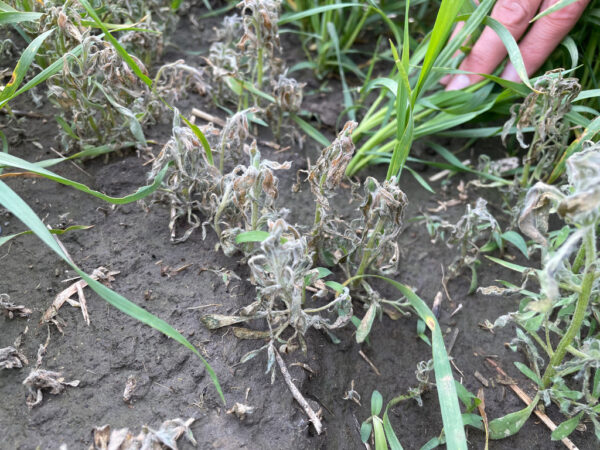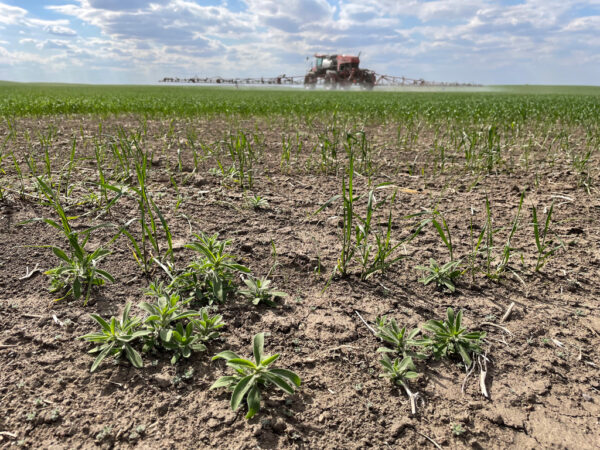
Brought to you by Corteva Agriscience
Expanding the herbicide-resistance management toolbox
March 18, 2024 in News
More is more when it comes to proactive herbicide resistance management.
For years, herbicide-resistant weeds have been a persistent challenge to Canadian producers. For cereal growers specifically, weeds like herbicide-resistant kochia and green and yellow foxtail, among others, have become prime troublemakers, threatening crop yields and profits.
Proactive management is key, and less is not more when it comes to the strategies and tools producers employ to get a handle on herbicide resistance.
An important – but often overlooked – part of this is understanding just how herbicide-resistant weeds develop, notes Rhett Duke, Technical Sales Agronomist, Southern Saskatchewan, with Corteva Agriscience.

Herbicide-resistant kochia has been a persistent problem for growers in Western Canada. Photo courtesy of Corteva Agriscience.
“Even in a field that has never seen a herbicide application, there will be a small number of individual [weeds] that are naturally resistant to the herbicide being sprayed,” he says, explaining that spraying a herbicide applies selection pressure across the field. When resistant weeds survive that application, they will reproduce and spread throughout the landscape, with genetic variability playing a part. This, Duke says, contributes to the onset of herbicide resistance, and management practices will further influence how a herbicide-resistant weed population grows.
“A higher overall weed population [equals] a higher chance that some resistant individuals will be present. If we’ve done a really good job managing weeds, that same risk isn’t going to be there,” he adds.
Multi-faceted management
Duke underscores the importance of cultural control practices, including narrow row spacing, increased seeding rate and good crop competition. The frequency of different active ingredients being used on the same target weeds is a contributing factor too.
“Applying one mode of action by itself is incredibly heavy-handed in terms of selecting for those resistant biotypes,” he adds.
“It goes hand-in-hand with crop rotation, as incorporating more crops in rotation opens up the number of herbicide options available to use in that field,” Duke continues, noting that the cycle of using the same mode of action year over year is a recipe for disaster. “Chemicals aren’t the only option. Cultural methods are absolutely critical to maintain the longevity and usefulness of our herbicides.”
Duke works with cereal producers in Western Canada who are facing weeds resistant to multiple modes of action, including kochia, green and yellow foxtail and wild oats, as well as other resistant biotypes like wild mustard, redroot pigweed and lamb’s-quarters, to name a few. A solid management program is key, and Duke notes that producers should have the long view in mind.
“It has to be a long-term strategy – at least three to five years, in terms of planning a herbicide rotation, in conjunction with minimum of a one-in-three crop rotation,” he advises, noting a canola-wheat-lentil rotation, which can be common across the southern Prairies, is effective at enabling different herbicide options.
“The worst thing we can do, in terms of managing herbicide-resistance development, is to become loyal to one herbicide brand and use it exclusively year after year. Growers need to be using as many different modes of action as possible,” Duke stresses, commenting on the importance of incorporating pre-seed and post-harvest applications to keep perennial and winter annual weeds at bay.
Adding something new into the mix
When adding new herbicides into a strategy, Duke reminds producers of how important it is to understand the product chemistry and label terms, including recropping restrictions. For wheat and barley producers in Western Canada who are dealing with herbicide resistant weeds, Duke recommends Corteva’s OnDeck herbicide, which uses a unique combination of Group 27 tolpyralate and Group 6 bromoxynil. “OnDeck’s chemistry will control groups 2-, 4-, 9- and 14-resistant kochia in the field, and Group 1- and Group 2- resistant green and yellow foxtail without a Group 1 or 2 graminicide in the tank,” Duke explains.

Corteva’s OnDeck herbicide uses a unique combination of Group 27 tolpyralate and Group 6 bromoxynil. Photo courtesy of Corteva Agriscience.
He also notes that OnDeck’s recropping flexibility might be particularly useful to lentil and chickpea growers in the Brown and Dark Brown soil zones who have heavier kochia populations. The product can be used in cereal crops the year before seeding crops like field pea, lentil, chickpea or canola, making it ideal to add into crop and chemistry rotations.
Duke cautions that when introducing any new herbicide, including OnDeck, it’s still important to rotate additional chemistries. “Don’t get predictable – use as many different active ingredients and products as possible,” he warns.
Conversely, he reminds growers not to count out a herbicide group just because resistance has been identified. “We still need to use those active ingredients because they will be effective on other weeds present in the field,” he says.
“We’re not going to stop or reverse herbicide resistance. The best thing we can do is slow it down as much as possible.”
Learn more about OnDeck here or speak to your advisor for more information.
Created by Amplify by Annex, in partnership with Corteva Agriscience and Top Crop Manager.
Advertisement
- New fungicide seed treatment delivers powerful protection for cereal growers
- Rethinking starter fertilizers and biostimulants